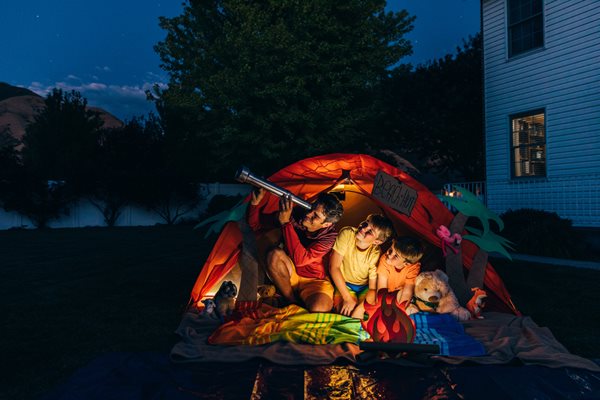
Top 8 Questions About the Jewish Calendar
When did the Jewish calendar begin?
According to the biblical Book of Exodus, it’s precisely when the Israelite slaves are about to go free that we see the first appearance of the Jewish calendar – as a map for their journey into freedom, because free people have control over their own time.
It says: “This month of Aviv (literally, “springtime,” later renamed Nisan) will be the first month of the year [because it marks your exodus from Egypt].”
Why do Jewish holidays sometime come “early” and sometimes “late”?
Whoa, that’s a Gregorian bias. In the Jewish calendar, every holiday comes at exactly the right time – and the same time each year. (Visit pjlibrary.org/holidays to learn more about each holiday.)
In contrast to the solar (Gregorian) calendar, the Jewish calendar follows the moon: a new moon signals a new month, and 29.5 days later, the next new moon – and its month – comes. (To make things “round” in the Jewish calendar, some months have 29 days and others 30 days.)
If you do the math, a 12-month lunar year lasts 354 days – 11 days short of a solar year. So if you only follow the moon, your holidays fall 11 days earlier each solar year, and before you know it, the springtime holiday of Passover shows up in winter and the winter holiday of Hanukkah has crept into summer. (In the lunar-only Muslim calendar, the month-long fast of Ramadan comes 11 days earlier each year and, as a result, can fall in any season.)
To keep each Jewish holiday in its intended season, a “leap month” is added to the Jewish calendar every two or three years. Relative to the Gregorian calendar, there’s a bit of sliding around (hence the “early” and “late” effect), but all within set limits.
In Gregorian terms, what’s the earliest and latest Jewish holidays fall?
- Rosh Hashanah (Jewish New Year) can fall as early as September 5 and as late as October 5.
- Hanukkah (Festival of Lights) can fall as early as November 28 (remember 2013’s “Thanksgivukkah”?) and as late as December 27 (Hanukkah-Christmas mash-ups are common).
- Passover (Festival of Freedom) can fall as early as March 21 and as late as April 20.
What does a leap year look like in the Jewish calendar?
Every two or three years (to be precise, 7 times every 19 years), the twelfth month of the Jewish year – Adar – is simply repeated. A leap year in Hebrew is called a shana me’uberet – a “pregnant year.” The holiday of Purim (Festival of Esther’s Bravery) falls in Adar. In a leap year – when Adar I is followed by (déjà vu!) Adar II – Purim falls in Adar II.
When do holidays begin and end?
Every holiday (like every day in the Jewish calendar) begins at sunset. Holidays end at nightfall when three stars appear in the sky.
Why do some people celebrate a Jewish holiday for one day and others celebrate the same holiday for two days?
Existentially, it’s because “where there are two Jews, there are three opinions.”
Historically, though, it’s because over 2,000 years ago it was the job of the High Court (The Sanhedrin) in Jerusalem to proclaim a new month based on eyewitness testimony of a new moon sighting. This is a tricky business for several reasons. First, there are cloudy nights. (Oy.) Second, the new moon appears every 29.5 days, making it unclear which day should be proclaimed as the first day of the month. Third, a totally cool system of “signal fires” – lighting torches on a series of mountaintops – was the way Jews in outlying communities were informed of the Jerusalem court’s proclamation, but distant communities were often too far away to get the flickering message.

At a certain point, the Rabbis decided that communities within Israel would keep one day of a holiday, and communities outside of Israel would keep an additional day in order to “cover” both days on which the holiday could potentially fall.
Today, Jews in Israel still keep holidays for one day (except Rosh Hashanah, which is two) while Diaspora Jewish practice varies – Conservative and Orthodox Jewish communities observe two days, in keeping with the rabbinic prescription, and Reform communities as well as many other Jews keep one. This divergence in practice applies to holidays mentioned in the Bible (Passover, Shavuot, Sukkot, Shemini Atzeret) but not to Yom Kippur (fasting for two days? that’s no fun) or to holidays that were later added to the calendar (Hanukkah, Purim, and Tu B’Shevat).
All of which is to say: If this year someone invites you to a “second seder” (ritual meal) on the second night of Passover, now you know why.
Is there a holiday for the new moon?
Of course. It’s called Rosh Chodesh, the “head of the month.” If a Jewish month has 29 days, Rosh Chodesh is celebrated for one day, and if the month has 30 days, then it’s celebrated for two days (the last day of the prior month AND the first day of the new month).

For moon lovers everywhere, here’s more on Rosh Chodesh.
As there are 12 months each year (and 13 in a leap year), there are lots of opportunities to celebrate Rosh Chodesh. But of course, that’s nothing compared to the most ubiquitous holiday on the Jewish calendar – Shabbat (the Jewish Sabbath), the holiday that comes every week.
Are the Jewish holidays interconnected? Is there an overarching structure to the Jewish calendar?
There are many connections between Jewish holidays. The more one celebrates and learns, the more connections one discovers.
Here’s one helpful way to understand the structure of the Jewish calendar:
- The “natural year” in Israel divides into two: the dry season (when traditional Jewish prayers bless the dew) and the wet season (when traditional Jewish prayers bless the rain).
- Two holidays serve as signposts for these respective seasons – Passover, the spring festival of freedom that begins on the full moon on Nisan (March or April in the Gregorian calendar), and Sukkot, the fall harvest festival that begins exactly six months later on the full moon of Tishrei (September or October in the Gregorian calendar). Each recalls – or actually, recreates – a different historical journey: on Passover, the journey from slavery in Egypt to freedom on the far side of the Red Sea; and on Sukkot, the 40-year journey through the desert to the Land of Israel.
- Passover is part of a winter-to-spring progression marked by a series of “miracles” leading from darkness to light. The progression begins with Hanukkah, which comes in the darkest days of the year and recalls the miracle of oil in the Jerusalem Temple that burned for eight days. This is followed by the miracle of the annual flowering of trees (Tu B’Shevat, the Birthday of the Trees), the miracle of one woman saving an entire community (Purim, the Festival of Esther’s Bravery), and finally, the miracle of liberation at Passover (Festival of Freedom) – two centuries of slavery coming to an end with the parting of a sea. This movement of darkness to light culminates, 49 days after Passover, with Shavuot (Festival of the Giving of the Torah), a moment of collective enlightenment in which the Ten Commandments are offered at Mount Sinai, an ethical blueprint for the future.
- Sukkot is part of a summer-to-fall progression in which we move from brokenness to wholeness. This progression begins with Tisha B’Av, a mid-summer day of mourning that recalls the destruction of the first and second Temple in Jerusalem and, more broadly, is about the presence of brokenness in the world. From the month before Rosh Hashanah (Jewish New Year) through the fast day of Yom Kippur (Day of Forgiving), we are challenged to identify what needs fixing in ourselves and our relationships and to begin to make amends. On Sukkot (Festival of Small Huts) we step into the sukkah (temporary hut) outside of our homes, and away from our possessions, to focus on some of the things that make and keep us whole: family, friends, good food, beautiful nature. Finally, much as Shavuot and the giving of the Torah (the first five books of the Bible) culminates the winter-to-spring progression, Simchat Torah (Dancing with the Torah) culminates the summer-to-fall progression: we read the end of the Torah scroll and begin it again, a circular dance with Judaism’s core book that is as richly cyclical as the Jewish calendar itself is.
July 28, 2021